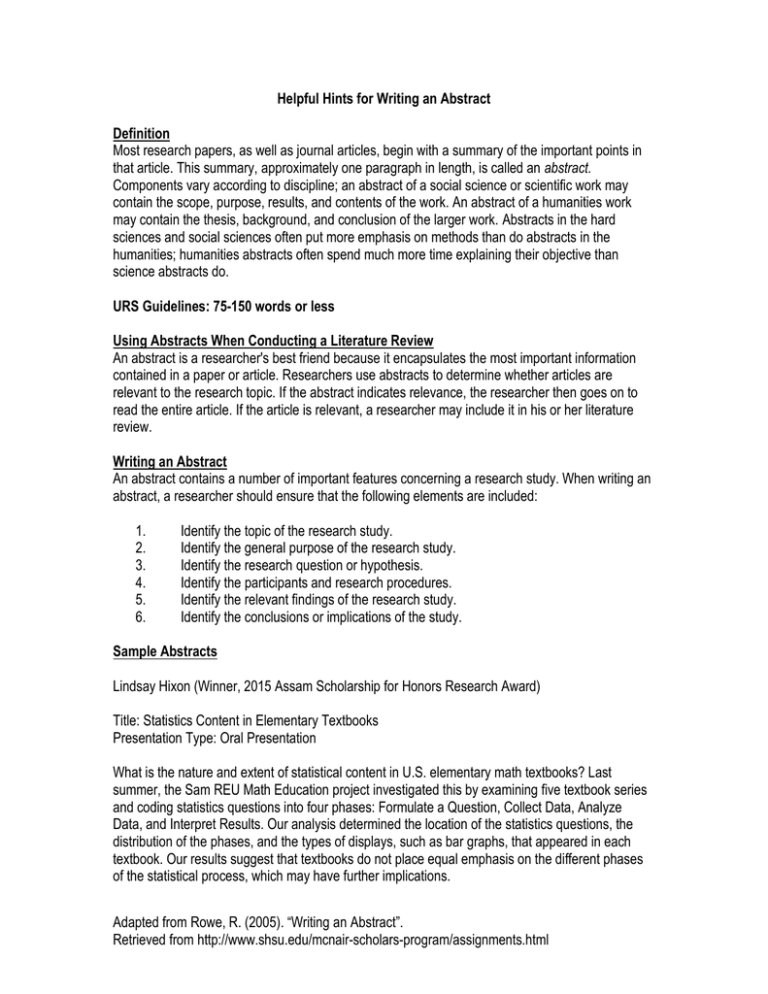Writing Effective Abstracts: Guidelines & Examples
advertisement

Helpful Hints for Writing an Abstract Definition Most research papers, as well as journal articles, begin with a summary of the important points in that article. This summary, approximately one paragraph in length, is called an abstract. Components vary according to discipline; an abstract of a social science or scientific work may contain the scope, purpose, results, and contents of the work. An abstract of a humanities work may contain the thesis, background, and conclusion of the larger work. Abstracts in the hard sciences and social sciences often put more emphasis on methods than do abstracts in the humanities; humanities abstracts often spend much more time explaining their objective than science abstracts do. URS Guidelines: 75-150 words or less Using Abstracts When Conducting a Literature Review An abstract is a researcher's best friend because it encapsulates the most important information contained in a paper or article. Researchers use abstracts to determine whether articles are relevant to the research topic. If the abstract indicates relevance, the researcher then goes on to read the entire article. If the article is relevant, a researcher may include it in his or her literature review. Writing an Abstract An abstract contains a number of important features concerning a research study. When writing an abstract, a researcher should ensure that the following elements are included: 1. 2. 3. 4. 5. 6. Identify the topic of the research study. Identify the general purpose of the research study. Identify the research question or hypothesis. Identify the participants and research procedures. Identify the relevant findings of the research study. Identify the conclusions or implications of the study. Sample Abstracts Lindsay Hixon (Winner, 2015 Assam Scholarship for Honors Research Award) Title: Statistics Content in Elementary Textbooks Presentation Type: Oral Presentation What is the nature and extent of statistical content in U.S. elementary math textbooks? Last summer, the Sam REU Math Education project investigated this by examining five textbook series and coding statistics questions into four phases: Formulate a Question, Collect Data, Analyze Data, and Interpret Results. Our analysis determined the location of the statistics questions, the distribution of the phases, and the types of displays, such as bar graphs, that appeared in each textbook. Our results suggest that textbooks do not place equal emphasis on the different phases of the statistical process, which may have further implications. Adapted from Rowe, R. (2005). “Writing an Abstract”. Retrieved from http://www.shsu.edu/mcnair-scholars-program/assignments.html Paige Odegard (Honorable Mention, 2015 Best Poster Presentation) Title: A Cartographic Timeline of Culture and Power Presentation Type: Poster Presentation This poster depicts the development of maps and how their social transactions adapted to globalization with an emphasis on prioritizing rhetorical aspects using the evolution of cartographic semiotics. The focus has evolved from artistically establishing religion and culture to a navigational tool and is now a robotic aid for direction. Ancient and present day cartographers are rhetoricians who strive to distinguish and assign power through maps using rhetorical aspects; for instance, early cartographers deemed pathos as the key aspect in maps in order to establish ethos, whereas present day maps focus on logos. Useful links: http://www.unc.edu/depts/wcweb/handouts/abstracts.html http://www.learning.wisc.edu/ugsymposium/abstracts.html Adapted from Rowe, R. (2005). “Writing an Abstract”. Retrieved from http://www.shsu.edu/mcnair-scholars-program/assignments.html



